We roll on in our review of the San Jose Sharks 2017-18 season. We covered the main points in our prior article. Here’s a look at the team’s forwards, an area of substantial change.
- Main Points
- Forwards
- Joe Thornton
- Defensemen (up next)
Sharks Redefine Their Forwards
With the departure of Patrick Marleau, the Sharks had a major void in their forward group. Or so it seemed. In reality, the Sharks finished the prior season with several injured forwards which made it difficult to assess the group. It turns out the group was more talented and capable than it appeared at the end of last season.
To start this season, younger forwards stepped in, stepped up and filled the void left by Marleau. But in January and February, the forward group redefined itself. Another major void opened up when Joe Thornton left the lineup in late January with a knee injury and was sidelined for the rest of the season. Thornton’s injury moved Joe Pavelski back to the center spot.
At the trade deadline in February, in separate deals, the Sharks acquired Eric Fehr and Evander Kane. Fehr was an upgrade at the fourth line center spot and Kane provided a scoring winger for Pavelski’s line. Both deals worked, but more importantly, they also changed the identity of the forward group and the team.
The Sharks went from attempting to emphasize speed and youth to a team with more quality power forwards than any team in hockey. Adding Fehr to the fourth line and Kane to Pavelski’s line gave the Sharks a power forward on each line. Tomas Hertl played on Logan Couture’s line and Timo Meier was on Chris Tierney’s line. Both Meier and Hertl topped the 20-goal mark. With Fehr (and often powerful winger Barclay Goodrow) on the fourth line, the Sharks rolled a deep, talented roster of power forwards. This became the team’s identity and was their path to success.
One player who I won’t review in detail here is Thornton. He merits a separate piece, the link is at the top of the article.
Top Sharks Forwards
The Sharks had five players who formed the core of their forward group: Pavelski, Hertl, Couture, Meier and late-season acquisition, Kane. This is a ton of talent.
Pavelski had a slow start but whatever was ailing him, seemed to go away in the closing months of the season. He finished with 66 points, though his 22 goals were his lowest total in several seasons. He also led the forwards in ice time per game and played in all 82 games.
After Thornton’s injury, Pavelski moved back to center and looked like a player who returned home. He has always had a well-rounded game and as a center, he was able to use more of his talents. He also made his linemates better. Many have questioned over the years whether the Sharks were too ‘top-heavy’ with Thornton and Pavelski on the same line. Pavelski’s play at center won’t make those questions go away. And it’ll make it harder to play him as a winger in the future.
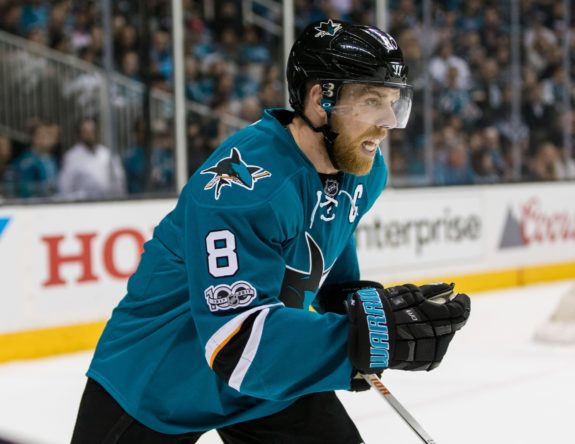
Couture was the Sharks’ most valuable player this season. He posted a career-high 34 goals and was among the team’s most effective defensive forwards. Two years ago, he led all NHL players in playoff scoring. In ten playoff games this season, he had a dozen points. Unfortunately, he was robbed on the most important play of the Sharks’ postseason by a stunning save from Vegas Golden Knights goalie Marc-Andre Fleury in overtime of Game 3.
Early in the season, it was apparent Couture was the team’s top center on the team’s top line, even if many continued to attribute the top line moniker to the Thornton-Pavelski line. From the day Thornton arrived in San Jose, the top line was the Thornton line. This year the baton passed, even if few formally recognized it.
Plenty happened over the course of the season to suggest Couture’s line merited top billing, even if it rarely got it. In the playoffs, his line was easily the team’s best with ten even-strength goals in ten games. The Pavelski line had two. One area where Couture improved, but still can’t be considered a success, is in the face-off circle. He won just 46 percent of his draws which is still better than the 39 percent he had in the prior season.
The power forwards Kane, Hertl and Meier came to define the forward group. The Sharks used one player on each line and it made them a difficult team to matchup against. Each player had over 20 goals on the season (most of Kane’s coming before the trade to San Jose) and each was a strong presence in front of the net. They were all able to draw penalties and keep possession of the puck. Their paths, however, differed greatly.
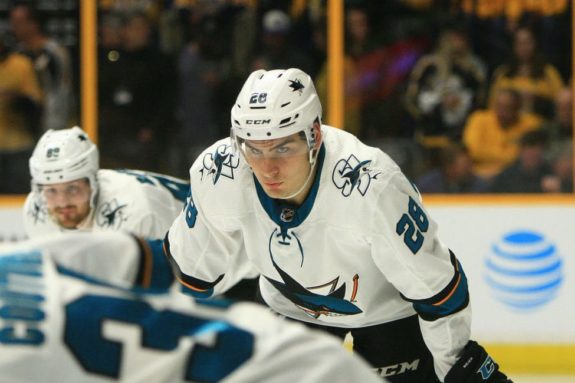
For Meier, his second NHL season was a major step in his development. He was the team’s most improved player. He had a very modest rookie season and wasn’t showing much in the early parts of this season. But once he figured out how to play in the NHL he took off. It wasn’t merely scoring for the youngest player on the team. He played with grit, dished out plenty of powerful hits (he led Sharks forwards in hits) and provided excellent screens in front of the goal. In short, he did the things that tend not to show on the scoresheet but that help win games. Reminiscent of Ryane Clowe, Meier’s future in San Jose looks particularly bright.
For Hertl, it was finally a healthy season. After breaking into the league with a bang, Hertl has fought a recurring knee injury and last season added a broken foot to the list. This season, he was a difference-maker and he paired well with Couture. Hertl was a beast in the playoff series against the Golden Knights; they struggled to contain him at every turn. Hertl led the team in face-offs draws, winning 50.8 percent.
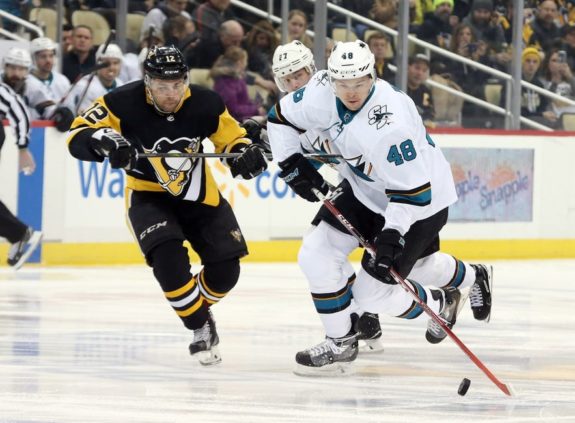
For Kane, in his ninth season, it was his first time on a playoff team. The winger not only added power but speed for a player of his size and strength. Playing on the line with the savvy Pavelski helped. Alas, Kane’s career has been marred by injuries. Until this season, he’d never exceeded 74 games played. Injuries hit him in his Sharks tenure, too.
He suffered both a separated shoulder and a knee (MCL) injury. It showed in his performance against Vegas, where the Sharks needed their power forwards to control play deep in the Vegas zone. In the series, he played more on the perimeter, likely due to his injuries, and finished the series with a disappointing minus-5. He was also suspended for a game for an extracurricular cross-check to the face of Pierre-Edouard Bellemare. Kane posted nine goals in 17 regular season games, earning his first NHL hat trick along the way.
The Sharks Forward Youth
Many of the Sharks’ younger forwards showed improvement. We already mentioned Meier and Hertl; the list also includes Chris Tierney, Kevin Labanc, Barclay Goodrow and Marcus Sorensen.
Tierney took a big jump, moving from fourth-line to third-line center. The bigger role didn’t just land him career bests in goals (17), assists (23) and points (40), it showed he can be effective against bigger opponents on a nightly basis. It’s also with noting, he was among the team’s better penalty-killers on a unit that was among the league’s best. He won a stellar 56.3 percent of face-offs while the team was short-handed. He was second on the team in the total number of face-offs taken, winning 51 percent.
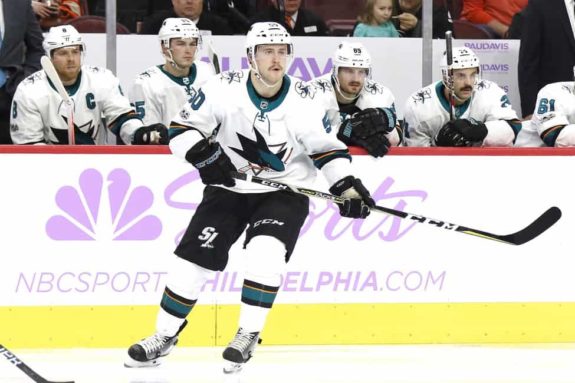
Labanc came off a decent rookie season and doubled his point total, going from 20 to 40. He regressed in the plus-minus area from plus-9 to minus-6 but became an important piece on the Sharks’ power play, where he had 17 points.
Labanc is effective in open ice but he’ll need to develop his game when there are less time and space available.
At even strength against a Vegas team that takes away both, Labanc was a non-factor. At age 22 and just 5’10”, Labanc is one of the smallest and youngest Sharks regulars. He has time to develop but he’ll need to improve if he’s to keep his NHL job.
Barclay Goodrow had, sort of, a break-out season. A regular on the Sharks’ fourth line, he only played 47 games due to injuries. And while 14 points and seven goals don’t sound like much, he was consistently effective. When he was played at center, instead of his normal spot on the wing, Goodrow led the Sharks by winning 58.8 percent of his face-offs. He figured nicely into the mix of a power forward-driven team. He was also effective on the penalty kill.
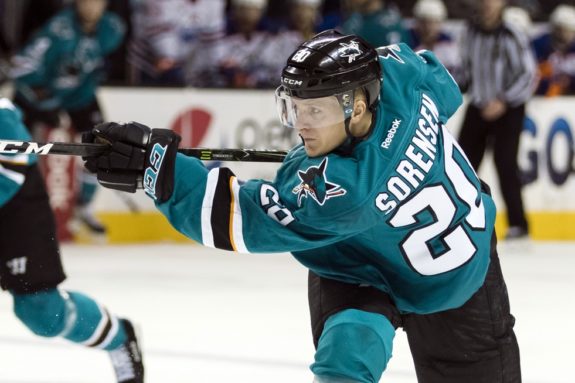
Sorensen had a disappointing regular season with just seven points in 32 games. The quickest Shark, he struggled to find his game much of the season. But in the regular season’s closing weeks, he showed an uptick in his game. Head coach Peter DeBoer noticed and started Sorensen in the series against the Anaheim Ducks.
Sorensen rewarded the coach by playing excellent hockey, generating four points and a plus-4 rating in the series sweep. He was good against Vegas, too. Despite his size, he plays with surprising physicality. His forecheck, play behind the net and aggressiveness along the walls is impressive for a player his size.
The Sharks moved on from two younger forwards during the season: Ryan Carpenter was waived (and picked up by Vegas) and Danny O’Regan went to the Buffalo Sabres as part of the Evander Kane trade.
San Jose’s Veteran Forwards
San Jose began with several veteran forwards set to fill out the lineup. It includes Joonas Donskoi, Joel Ward, Jannik Hansen, Melker Karlsson and Mikkel Boedker along with newcomers Kane and Fehr. This group met with mixed results.
Both Ward and Hansen saw plenty of time outside the starting lineup. Both players have contracts set to expire on July 1 and it’s unlikely either returns. Ward, with just 12 points on the season, might be done as an NHL player. For a guy who was always an underdog, he carved out a nice NHL career, had more than his share of big moments and gained a whole lot of friends and admirers.
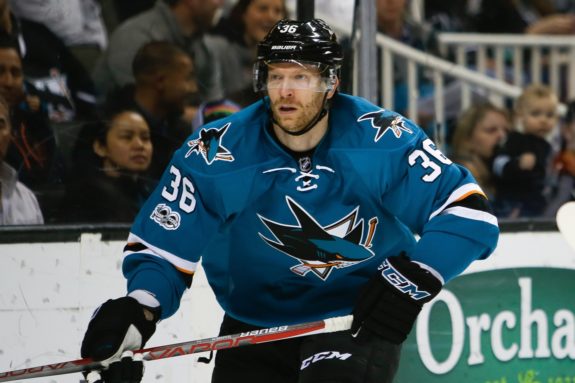
Hansen had 14 points, though he played well towards the end of the season. He’ll find an NHL job next season but not in San Jose. The combination of the Sharks’ depth and inconsistent play on his part, especially in the first half of the season, kept him in a diminished role or on the bench. Though healthy, neither Ward nor Hansen played in the playoffs this season.
Karlsson didn’t look particularly healthy for much of the season and had a down year as a result. Despite playing a career-high 71 games, he tied his career low of 19 points and posted a career-worst minus-5. Early in the season, he was on the top line with Couture and Hertl and they were effective together. But by season’s end Karlsson was on the fourth line. He did have a good playoffs; the additional rest before the playoffs and between series likely helped him a fair bit. He is another player who was good on the penalty kill.
Donskoi had a good season overall, though he too seemed to have occasional health issues, including in the series against Vegas. He posted 32 points and a career best plus-10 rating. Still, he looks like he has yet to reach his potential, even though he’s at the age where he should be at his peak. He finished the season on a line with Joe Pavelski and Evander Kane.
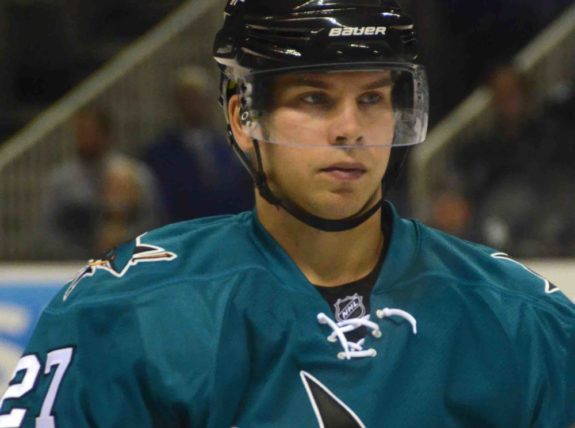
The speedy Boedker was among the Sharks’ better turnaround stories. After struggling for a season and a half, he finally fit in. Beginning with the 2018 part of the season, he was, at long last, an asset. In the series against Vegas, he was slotted in on the line with Couture and Hertl. Boedker’s skating behind the net with the puck led to three goals and twice he assisted on goals coming from behind the net. He also drew a tripping penalty and the power play scored.
Eric Fehr’s NHL career was in question when the Sharks acquired him with a seventh-round draft pick. He was playing in the AHL with the San Diego Gulls (where he was on loan from the Toronto Maple Leafs). Fehr was good in a bunch of ways. His chemistry with his the fourth-line linemates was immediate and San Jose’s depth, an asset all season, became even more important.
He was decent on face-offs, played well on the penalty kill and provided guidance on a line that utilized his physicality, skills and veteran presence. He managed a plus-7 rating in just 14 regular season games. There’s little doubt Fehr’s stint with the Sharks was a win-win. He helped the team succeed and improved his ongoing NHL career prospects.
Expectations and Results
All in all, San Jose got a lot from their forwards without much from the legends that had dominated the group for over a decade. Nine forwards netted double-digit goals while Kane just missed with nine. A surprisingly large number of forwards finished the season just about even. Meier, Hansen, Goodrow, Pavelski, Tierney, Boedker, Couture, Hertl and Ward all finished between minus-2 and plus-3.
DeBoer believes the NHL is a four-line game, meaning all 12 forwards in the lineup are important to succeed. I agree and wish he was more aggressive in balancing the lines than he has been. The Sharks’ forward depth was a major asset this season. Credit must be given to DeBoer and general manager, Doug Wilson, for putting together and developing a strong, deep forward group, especially in the absence of Thornton and Marleau.
It’s worth noting how much the group changed over the season. On opening night, Thornton, Hansen and Ward were on the ice. By season’s end, they were replaced with Fehr, Sorensen and Kane, almost 25 years younger among the three players. The Sharks got younger, they got deeper and it appears they got better. It’s a good result given all the question marks the forward group faced.